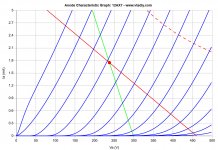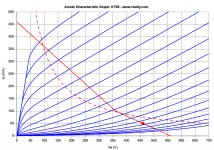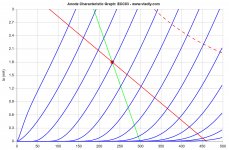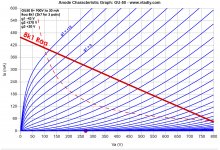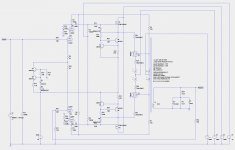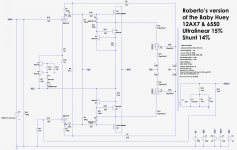matejsirk has already done A BH with GU50 in pentode/cathode feedback in 2005.
Attachments
Last edited:
Yes, but this amp isn't UL.
Best regards!
It is, please read the link: https://www.diyaudio.com/forums/tub...l-separate-g2-winding-supply.html#post3568913
In this treat it is AB2 with 400V on the screen and yes AB1 for 600V,
https://www.diyaudio.com/forums/tub...l-separate-g2-winding-supply.html#post3568913
I don't now if he mend AB1 is without grid current.If so I don't see him get more then 90W sine.
Mona
That link shows two examples, one AB2 and one AB1, and the plot of the oscilloscope is for the secon "aggressive" case in AB1.
Why you say 90 W? it's 700 Vp, so 496,45 Vrms into 7k8 Raa, that's 125 Wrms. Isn't it?
Last edited:
matejsirk has already done A BH with GU50 in pentode/cathode feedback in 2005.
Thanks kokoriantz, this is the original post: GU-50 PP amp project - Any favs?
It was 2015 and he said that it may be one of his next projects, not done yet.
LTSpice simulations: Pmax 65W, THD less that 0.4%, Zout only 0.4 Ohm.
This is pentode PP with cathode feedback, 650V B+, 280V on g2, -42V on g1, shunt feedback on pentode drivers, strictly AB1 without mosfets to drive g1.
I'm contacting him to ask him to partecipate to the thread.
Yes, but that means 360mA at Va=100V.And you need positive grid for that, so grid curent.That link shows two examples, one AB2 and one AB1, and the plot of the oscilloscope is for the secon "aggressive" case in AB1.
Why you say 90 W? it's 700 Vp, so 496,45 Vrms into 7k8 Raa, that's 125 Wrms. Isn't it?
Mona
Yes, but that means 360mA at Va=100V.And you need positive grid for that, so grid curent.
Mona
Thanks Mona, what is your interpretation of the data shown in that post?
So you say it is needed to go AB2, es345 says it is AB1 (probably he want to say that the circuit cannot drive the GU50s into AB2?), so the real loadline will be different? In any case the FFT isn't that bas at 120 Wrms.
What do you think?
PS
One more question: am I wrong saying that from the data shown, it is working above the maximum dissipation curve?
Last edited:
I've found another thread where es345 is talking about GU50, and from where some more data can be taken (but note that he is talking about the bass amp with 10% cathode feedback and mosfet to go to AB2):
GU-50 Push-Pull AB OT Impedance/Load Line Questions
GU-50 Push-Pull AB OT Impedance/Load Line Questions
In this post and the following you will see possible solutions for BH tubes that would be nice to discuss.
First one is 6550:
B+460V Ia72mA g1-50V g2460V Raa5k2 UL.
It has a gain of 400/50 = 8.
I've modified the 12AX7 plate and shunt feedback from 220 & 47 & 16 kOhm to 100 & 27 & 8.2 kOhm with an idle current from 0,6 to 1,75 mA.
Feedback is 1/7,6 and the load seen by the 12AX7 is 48 kOhm.
Working point is a bit on the edge of the driver capability, but it should have 14 Wrms in Class A before going AB1.
Load lines in attachment.
First one is 6550:
B+460V Ia72mA g1-50V g2460V Raa5k2 UL.
It has a gain of 400/50 = 8.
I've modified the 12AX7 plate and shunt feedback from 220 & 47 & 16 kOhm to 100 & 27 & 8.2 kOhm with an idle current from 0,6 to 1,75 mA.
Feedback is 1/7,6 and the load seen by the 12AX7 is 48 kOhm.
Working point is a bit on the edge of the driver capability, but it should have 14 Wrms in Class A before going AB1.
Load lines in attachment.
Attachments
KT88, following the datasheet:
https://frank.pocnet.net/sheets/084/k/KT88_GEC.pdf
B+ 460V, Ia 55mA, Raa 4 kOhm, UL, g1 -58V, g2 460 V.
It has a gain of 6,56.
With the same 12AX7 plate and shunt feedback at 100 & 27 & 8.2 kOhm, an idle current of 1,8 mA and the grid at -1,5V.
Feedback is 1/7,6 and the load seen by the 12AX7 is 53 kOhm, that's better for the increase in needed swing that the KT88 needs in this configuration.
https://frank.pocnet.net/sheets/084/k/KT88_GEC.pdf
B+ 460V, Ia 55mA, Raa 4 kOhm, UL, g1 -58V, g2 460 V.
It has a gain of 6,56.
With the same 12AX7 plate and shunt feedback at 100 & 27 & 8.2 kOhm, an idle current of 1,8 mA and the grid at -1,5V.
Feedback is 1/7,6 and the load seen by the 12AX7 is 53 kOhm, that's better for the increase in needed swing that the KT88 needs in this configuration.
Attachments
This could be a possible solution for the GU50, the driver should be the same as the one in the previous post, but there's need of dropping around 450 V on the DC side (independently from the current flowing through it) without affecting the signal AC.
Is there something smarter than referring the "ground" of the phase inverter to +450V?
Thanks
Roberto
Is there something smarter than referring the "ground" of the phase inverter to +450V?
Thanks
Roberto
Attachments
I've sketched this version with GU50s and Raa 8k with UL taps at 20%.
PI has ultralinear cascode 12ax7s, to keep the concept of applying local feedback.
With 1,7 Vp at its input:
With 2 Vp at its input:
With 2,2 Vp at its input:
PI has ultralinear cascode 12ax7s, to keep the concept of applying local feedback.
With 1,7 Vp at its input:
Code:
Harmonic Frequency Fourier Normalized Phase Normalized
Number [Hz] Component Component [degree] Phase [deg]
1 1.000e+03 2.946e+01 1.000e+00 -0.83° 0.00°
2 2.000e+03 2.700e-03 9.168e-05 132.88° 133.71°
3 3.000e+03 5.040e-02 1.711e-03 90.37° 91.19°
4 4.000e+03 1.474e-03 5.004e-05 147.12° 147.95°
5 5.000e+03 5.523e-02 1.875e-03 163.85° 164.67°
6 6.000e+03 1.076e-03 3.652e-05 -163.87° -163.05°
7 7.000e+03 9.203e-03 3.124e-04 -4.39° -3.57°
8 8.000e+03 7.681e-04 2.608e-05 -173.95° -173.12°
9 9.000e+03 3.925e-03 1.333e-04 166.16° 166.99°
Total Harmonic Distortion: 0.256358%(0.256548%)With 2 Vp at its input:
Code:
Harmonic Frequency Fourier Normalized Phase Normalized
Number [Hz] Component Component [degree] Phase [deg]
1 1.000e+03 3.536e+01 1.000e+00 -0.85° 0.00°
2 2.000e+03 3.800e-03 1.074e-04 124.70° 125.55°
3 3.000e+03 1.404e-01 3.971e-03 26.08° 26.93°
4 4.000e+03 1.797e-03 5.081e-05 142.52° 143.37°
5 5.000e+03 1.491e-01 4.216e-03 166.54° 167.40°
6 6.000e+03 1.481e-03 4.189e-05 134.41° 135.26°
7 7.000e+03 1.442e-02 4.078e-04 1.88° 2.73°
8 8.000e+03 1.582e-03 4.472e-05 -137.49° -136.64°
9 9.000e+03 9.446e-03 2.671e-04 -12.39° -11.54°
Total Harmonic Distortion: 0.581349%(0.581530%)With 2,2 Vp at its input:
Code:
Harmonic Frequency Fourier Normalized Phase Normalized
Number [Hz] Component Component [degree] Phase [deg]
1 1.000e+03 3.851e+01 1.000e+00 -0.87° 0.00°
2 2.000e+03 3.858e-02 1.002e-03 90.59° 91.46°
3 3.000e+03 4.354e-01 1.131e-02 6.86° 7.73°
4 4.000e+03 2.417e-02 6.276e-04 -99.66° -98.79°
5 5.000e+03 2.825e-01 7.337e-03 168.29° 169.16°
6 6.000e+03 1.563e-02 4.059e-04 85.35° 86.22°
7 7.000e+03 3.435e-02 8.919e-04 -2.39° -1.52°
8 8.000e+03 5.033e-03 1.307e-04 -114.07° -113.20°
9 9.000e+03 1.099e-03 2.853e-05 36.76° 37.63°
Total Harmonic Distortion: 1.356768%(1.357172%)Attachments
Last edited:
Following latest gingertube's posts, I add this other version of the Baby Huey with the 6550.
Code:
Harmonic Frequency Fourier Normalized Phase Normalized
Number [Hz] Component Component [degree] Phase [deg]
1 1.000e+03 3.667e+01 1.000e+00 -1.57° 0.00°
2 2.000e+03 3.578e-03 9.756e-05 172.11° 173.67°
3 3.000e+03 2.680e-01 7.306e-03 122.33° 123.90°
4 4.000e+03 5.277e-03 1.439e-04 127.32° 128.89°
5 5.000e+03 3.720e-01 1.014e-02 169.70° 171.27°
6 6.000e+03 3.301e-03 9.000e-05 171.10° 172.67°
7 7.000e+03 1.757e-03 4.791e-05 9.74° 11.31°
8 8.000e+03 2.422e-03 6.603e-05 157.93° 159.50°
9 9.000e+03 7.793e-02 2.125e-03 16.89° 18.46°
Total Harmonic Distortion: 1.268177%(1.275905%)Attachments
These are the results with 390 kOhm instead of 470 kOhm on PI's plates and 700 uA instead of 600 uA (2.2 kOhm instead of 2.6):
Here with 330 kOhm and 800 uA (1.8 kOhm):
Here with 270 kOhm and 1.1 mA (1.5k):
Here with 220 kOhm and 1.5 mA (1 kOhm):
Code:
Harmonic Frequency Fourier Normalized Phase Normalized
Number [Hz] Component Component [degree] Phase [deg]
1 1.000e+03 3.606e+01 1.000e+00 -1.53° 0.00°
2 2.000e+03 3.984e-03 1.105e-04 158.13° 159.66°
3 3.000e+03 2.906e-01 8.058e-03 130.83° 132.36°
4 4.000e+03 5.236e-03 1.452e-04 129.60° 131.13°
5 5.000e+03 3.420e-01 9.482e-03 168.40° 169.93°
6 6.000e+03 3.361e-03 9.319e-05 167.71° 169.24°
7 7.000e+03 1.793e-02 4.972e-04 24.84° 26.37°
8 8.000e+03 2.372e-03 6.577e-05 158.08° 159.61°
9 9.000e+03 7.589e-02 2.104e-03 18.76° 20.29°
Total Harmonic Distortion: 1.263144%(1.269129%)Here with 330 kOhm and 800 uA (1.8 kOhm):
Code:
Harmonic Frequency Fourier Normalized Phase Normalized
Number [Hz] Component Component [degree] Phase [deg]
1 1.000e+03 3.576e+01 1.000e+00 -1.49° 0.00°
2 2.000e+03 4.201e-03 1.175e-04 159.45° 160.93°
3 3.000e+03 3.050e-01 8.530e-03 135.32° 136.81°
4 4.000e+03 5.219e-03 1.460e-04 131.97° 133.45°
5 5.000e+03 3.248e-01 9.085e-03 166.90° 168.39°
6 6.000e+03 3.421e-03 9.567e-05 166.34° 167.82°
7 7.000e+03 2.750e-02 7.691e-04 28.08° 29.56°
8 8.000e+03 2.392e-03 6.690e-05 156.83° 158.32°
9 9.000e+03 7.282e-02 2.037e-03 20.01° 21.49°
Total Harmonic Distortion: 1.265201%(1.270179%)Here with 270 kOhm and 1.1 mA (1.5k):
Code:
Harmonic Frequency Fourier Normalized Phase Normalized
Number [Hz] Component Component [degree] Phase [deg]
1 1.000e+03 3.501e+01 1.000e+00 -1.45° 0.00°
2 2.000e+03 4.620e-03 1.320e-04 153.32° 154.77°
3 3.000e+03 3.336e-01 9.529e-03 141.44° 142.89°
4 4.000e+03 5.137e-03 1.467e-04 135.11° 136.57°
5 5.000e+03 2.922e-01 8.346e-03 165.07° 166.52°
6 6.000e+03 3.459e-03 9.881e-05 163.77° 165.22°
7 7.000e+03 4.262e-02 1.217e-03 27.44° 28.90°
8 8.000e+03 2.331e-03 6.658e-05 156.32° 157.77°
9 9.000e+03 6.630e-02 1.894e-03 22.11° 23.56°
Total Harmonic Distortion: 1.286758%(1.290578%)Here with 220 kOhm and 1.5 mA (1 kOhm):
Code:
Harmonic Frequency Fourier Normalized Phase Normalized
Number [Hz] Component Component [degree] Phase [deg]
1 1.000e+03 3.585e+01 1.000e+00 -1.37° 0.00°
2 2.000e+03 6.431e-03 1.794e-04 -140.45° -139.08°
3 3.000e+03 3.085e-01 8.604e-03 139.21° 140.58°
4 4.000e+03 4.873e-03 1.359e-04 148.08° 149.45°
5 5.000e+03 3.163e-01 8.824e-03 163.30° 164.67°
6 6.000e+03 3.726e-03 1.039e-04 164.54° 165.91°
7 7.000e+03 3.618e-02 1.009e-03 39.10° 40.48°
8 8.000e+03 2.758e-03 7.693e-05 150.12° 151.49°
9 9.000e+03 6.681e-02 1.864e-03 21.70° 23.07°
Total Harmonic Distortion: 1.250787%(1.254495%)- Home
- Amplifiers
- Tubes / Valves
- Baby Huey enters into puberty: 6550 KT88 possibly GU50?

